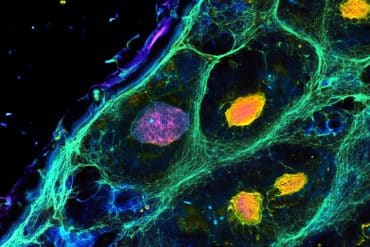Summary: Researchers report metabolite profiles alter in young people who consume alcohol at socially acceptable levels. Additionally, researchers found reduced gray matter volume in young women who are heavy drinkers.
Source: University of Eastern Finland.
Adolescent drinking is associated with changes in the metabolite profile, a new study from the University of Eastern Finland and Kuopio University Hospital shows. Some of these changes were found to correlate with reduced brain grey matter volume, especially in young women who are heavy drinkers. The findings shed new light on the biological implications of adolescent drinking, and could contribute to the development of new treatments.
“For instance, heavy-drinking adolescents showed increased concentrations of 1-methylhistamine, which, in turn, was associated with reduced brain grey matter volume,” Researcher Noora Heikkinen from the University of Eastern Finland explains.
1-methylhistamine is formed in the brain from histamine produced by immune responses.
“Our findings suggest that the production of histamine is increased in the brains of heavy-drinking adolescents. This observation can help in the development of methods that make it possible to detect adverse effects caused by alcohol at a very early stage. Possibly, it could also contribute to the development of new treatments to mitigate these adverse effects.”
The study was a 10-year follow-up study among adolescents living in eastern Finland. The researchers determined the metabolite profiles of heavy- and light-drinking young adults, and used MRI to measure their brain grey matter volumes. These two methods have not been used in combination before, although previous studies have shown an association between heavy drinking and metabolite profile changes.

“What is new and significant about our study is the fact that we observed metabolite profile changes even in young people who consumed alcohol at a level that is socially acceptable. Moreover, none of the study participants had a diagnosis of alcohol dependence.”
The findings indicate that even drinking that is not considered excessive has adverse effects on young people, both on their metabolism and brain grey matter volume, on the latter of which the research group has published findings already earlier.
“Although adolescent drinking is declining on average, we can see polarization: some adolescents are very heavy drinkers and they also use other substances,” Heikkinen adds.
Source: Noora Heikkinen – University of Eastern Finland
Publisher: Organized by NeuroscienceNews.com.
Image Source: NeuroscienceNews.com image is in the public domain.
Original Research: Abstract for “Changes in the serum metabolite profile correlate with decreased brain grey matter volume in moderate-to-heavy-drinking young adults” by Noora Heikkinenab, Olli Kärkkäinen, Eila Laukkanen, Virve Kekkonen, Outi Kaarreb, Petri Kivimäki, Mervi Könönen, Vidya Velagapud, Jatin Nandania, Soili M. Lehto, Eini Niskanen, Ritva Vanninen, and Tommi Tolmunen in Alcohol. Published May 31 2018.
doi:10.1016/j.alcohol.2018.05.010
[cbtabs][cbtab title=”MLA”]University of Eastern Finland”Drinking Changes Young Adults’ Metabolite Profile.” NeuroscienceNews. NeuroscienceNews, 1 July 2018.
<https://neurosciencenews.com/drinking-youth-metabolites-9490/>.[/cbtab][cbtab title=”APA”]University of Eastern Finland(2018, July 1). Drinking Changes Young Adults’ Metabolite Profile. NeuroscienceNews. Retrieved July 1, 2018 from https://neurosciencenews.com/drinking-youth-metabolites-9490/[/cbtab][cbtab title=”Chicago”]University of Eastern Finland”Drinking Changes Young Adults’ Metabolite Profile.” https://neurosciencenews.com/drinking-youth-metabolites-9490/ (accessed July 1, 2018).[/cbtab][/cbtabs]
Abstract
Changes in the serum metabolite profile correlate with decreased brain grey matter volume in moderate-to-heavy-drinking young adults
Our aim was to analyse metabolite profile changes in serum associated with moderate-to-heavy consumption of alcohol in young adults and to evaluate if these changes are connected to reduced brain grey matter volumes. Study population consisted of young adults with a ten-year history of moderate-to-heavy alcohol consumption (n = 35) and light-drinking controls (n = 27). We used targeted liquid chromatography mass spectrometry method to measure concentrations of metabolites in serum and 3.0 T magnetic resonance imaging to assess brain grey matter volumes. Alterations in amino acid and energy metabolism were observed in the moderate-to-heavy drinking young adults when compared to the controls. After correction for multiple testing, the group of moderate-to-heavy drinking young adults had increased serum concentrations of 1-methylhistamine (p = 0.001, d = 0.82) when compared to the controls. Furthermore, concentrations of 1-methylhistamine (r = -0.48, p = 0.004) and creatine (r = -0.52, p = 0.001) were negatively correlated with the brain grey matter volumes in the females. Overall, our results show association between moderate-to-heavy use of alcohol and altered metabolite profile in young adults as well as suggest that some of these changes could be associated with the reduced brain grey matter volume.






